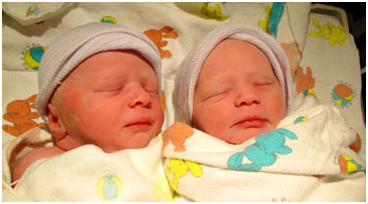

|
|
Pregnant with twins
What causes twins
A couple is more likely to have twins if there are twins in the woman's family. Triplets occur naturally in 1 in 10,000 pregnancies, and quads are even rarer. Nowadays, the use of drugs in the treatment of infertility has made multiple births more common.
There are two types of twin pregnancy.
Identical twins
Identical (monozygotic) twins happen when a single egg (zygote) is fertilised. The egg then divides into two, creating identical twins who share the same genes as one another. Identical twins are always the same sex, so if you're twins are identical you'll have two girls or two boys, and they'll look very alike.
Non-identical twins
Non-identical (dizygotic) twins happen when two separate eggs are fertilised and then implant into the woman’s womb (uterus). These non-identical twins are no more alike than any other two siblings. Non-identical twins are more common. The babies may be of the same sex or different sexes. One-third of all twins will be identical and two-thirds non-identical.
Are you carrying twins?
You might suspect that you are carrying more than one baby if:
It is usually possible to find out if you're having twins through your dating ultrasound scan, which happens when you are 8-14 weeks pregnant.
 You should be told at this point whether the babies share a placenta (which means they are identical) or whether they have two separate placentas (which means they can be either identical or non-identical). If this cannot be determined, you should be offered a further scan. One-third of identical twins have two separate placentas. This happens when the fertilised egg splits in the first three or four days after conception and before it implants in the uterus.
What causes twins?
No one knows what causes identical (also called monozygotic) twins. It appears that all women, irrespective of ethnicity, have an equal chance of having identical twins and that the chance is approximately one in 350-400. Identical twins do not run in families.
Some factors make non-identical twins more likely:
How can I tell if my twins are identical?
The most accurate way to tell if twins are identical is through a DNA test, which can be done after the babies are born. The placenta could also provide the answer. If your first ultrasound scan is done before 14 weeks, it should be possible to tell accurately the type of placenta your twins have. Otherwise the placenta can be examined after the birth. However, neither of these methods is foolproof.
All non-identical twins and one-third of identical twins have exactly the same type of dichorionic placenta. This is when each baby has its own separate placenta with its own separate inner membrane (amnion) and outer membrane (chorion). These types of twins are called dichorionic diamniotic (DCDA).
Two-thirds of identical twins have a single placenta with a single outer membrane and two inner membranes. These are called monochorionic diamniotic (MCDA). About 1% of monochorionic twins will also share the inner membrane. These are called monochorionic monoamniotic (MCMA).
Feeding twins
It is possible to breastfeed twins and even triplets. You may find that a combination of breast and formula feeding is best for you, particularly if you have triplets or more.
Myths about twins
There are many myths about twins. Here, we separate fact from fiction.
Myth: Twins run in families
Fact: There is no evidence that identical twins run in families. However, it is possible that a family could have a genetic predisposition to non-identical twins, probably due to the woman having a predisposition to releasing more than one egg each month when she ovulates.
Myth: Twins skip a generation
Fact: It is a common misconception that twins skip a generation in families. You may have heard, for example, that if your father is a twin but you're not, you're more likely to have twins yourself. There's no evidence to support this. However, some women may have a genetic predisposition to hyperovulation, where they produce more than one egg during a menstrual cycle. This makes it more likely that they will have twins. If this is the case, twins are just as likely to be born to each generation as they are to skip one.
Myth: Having lots of morning sickness means you’re pregnant with twins
Fact: Not necessarily. Although some mothers expecting multiple births report lots of morning sickness, other mothers who are pregnant with twins or more don’t experience any morning sickness. Some pregnant women have nausea and vomiting and some don’t, whether or not they’re carrying twins.
Myth: Twins speak their own secret language
Fact: Twins have an innate understanding of each other and, as a result, may speak in their own code. Also, because they spend so much time together, one may pick up words said wrongly by the other twin that they both understand, which can be perceived as a twin language by other people.
Myth: All pregnancies start out as twin pregnancies
Fact: It isn’t true that all pregnancies start out as twin pregnancies. However, thanks to early pregnancy scans, it has been discovered that more pregnancies than we thought do start out with two fertilised eggs.
It's possible that if you're scanned before 12 weeks, you'll see two foetal heartbeats and two foetal sacs, but one will have disappeared by the 12-week scan. This is because one of the embryos failed to thrive and it has been reabsorbed into the womb. This is referred to as vanishing twin syndrome and has no physical effect on the surviving baby. |





